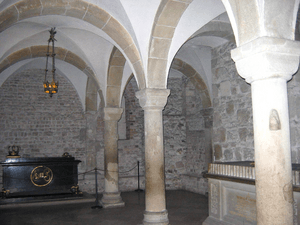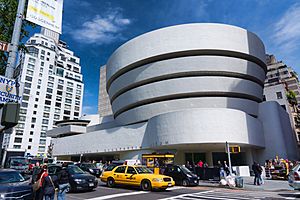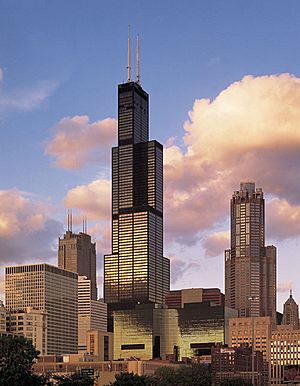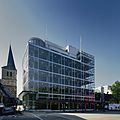Architecture facts for kids
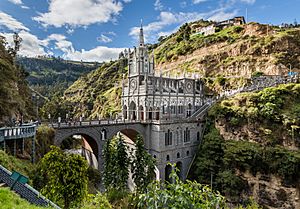
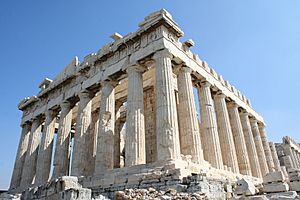
Architecture is the science of the design of structures or buildings such as houses, places of worship, and office buildings. Architecture is also the profession of an architect. A person must study at an institution of higher education (university) to become an architect. Architecture can be about small designs, such as a garage, or large designs, such as a whole city. Architecture often overlaps with civil engineering, and architects and civil engineers often work together.
Contents
History
In the past, people built huts and wood houses to protect themselves from the weather. For safety, they were often close together. Great civilizations like the Ancient Egyptians built large temples and structures, like the Great Pyramids of Giza. The Ancient Greeks and Romans made what we now call "Classical Architecture". The Romans, working over 2000 years ago, copied the arch from the Etruscans, who copied it from the Mesopotamians. The stone columns, which still hold up so many important buildings, like the Parthenon in Athens, were simply copied from the first wooden posts.
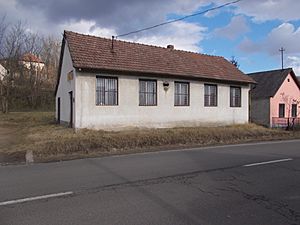
Classical Architecture was very formal, and it always obeyed laws. It used symmetry, which really means balance, and it used proportion which means keeping shapes in certain ways. The Golden Mean was a rule (or law) which said, (to put it very simply) if you are making a room, or any other thing, it will work best if you always make the long side 1.6 times longer than the short side. There are many laws in Classical Architecture, like how high the middle of an arched bridge needs to be (which depends on how wide the bridge needs to be). These laws were learned from thousands of years of experience and they are as true today as they were 2000 years ago.
In some parts of the world, like India, the architecture is famous for carving the stone on temples and palaces. Different architectural styles were made in China, Japan, Southeast Asia, Africa, Mexico, and Central and South America.
Later, people in Western Europe in the Middle Ages made Romanesque architecture, then Gothic architecture. Gothic buildings have tall, pointed windows and arches. Many churches have Gothic architecture. Castles were also built at this time. In Eastern Europe, churches usually had domes. People added their own ideas and decoration to the Classical Architecture of the past. The Renaissance brought a return to classical ideas.
In the late 18th century with the Industrial Revolution, people began to invent machines to make things quickly and cheaply. Many factories and mills were built during, or after this revolution. Decades later, in the Victorian era, architects like George Fowler Jones and Decimus Burton still followed the Gothic style to build new churches. Up to this point, buildings were limited in size and style by the strength of the wood and masonry used to construct them. Gothic cathedrals were among the largest buildings because the gothic arch when combined with buttresses allowed stone buildings to be built taller. For example, the cathedral in Ulm, Germany is over 500 feet tall. However, building with stone has its limits, and building too tall could result in collapse, an example of which is the Beauvais Cathedral, which was never completed.
Towards the end of the 19th Century with a second Industrial Revolution, steel became much cheaper. Architects began to use inventions like metal girders and reinforced concrete to build. An example is the Eiffel Tower in Paris. Buildings can now be built taller than ever before. We call them skyscrapers. This new technology has made us free from traditional limitations, and because of the new possibilities presented by these materials, many traditional methods of construction and ideas about style were reevaluated, replaced, or abandoned. Cheap, strong glass soon brought transparent exterior walls, especially for office buildings.
Modernism is the name for the architectural style which developed because of these new building technologies, and its beginnings can been seen as early as 1890. Modernism can also refer to a specific group of architects and buildings from the early to late 20th century, and so may not be the proper term to use for many building built since then, which are sometimes called "post-modern".
Many of the world's greatest structures were built by modern-day architects such as Frank Lloyd Wright, I. M. Pei, Adrian Smith, Edward Durell Stone, Fazlur Khan, and Bruce Graham.
Related pages
- Architect
- Art
- List of buildings
- Skyscraper
- Structural Engineering
- Acoustics
- Building code
- Building materials
- Pattern language
- World Heritage Sites
- Architecture of Africa
Images for kids
-
In adding the dome to the Florence Cathedral (Italy) in the early 15th century, the architect Filippo Brunelleschi not only transformed the building and the city, but also the role and status of the architect.
-
Illustration of bracket arm clusters containing cantilevers from Yingzao Fashi, a text on architecture by Li Jue (1065–1110)
-
Plan of the second floor (attic storey) of the Hôtel de Brionne in Paris – 1734.
-
The National Congress of Brazil, designed by Oscar Niemeyer
-
In Norway: wood and elevated-level
-
In Lesotho: rondavel stones
-
In Ireland: Yola hut
-
Göbekli Tepe from Turkey, founded in 10th millennium BC and abandoned in 8th millennium BC
-
Pottery miniature of a Cucuteni-Trypillian house
-
Excavated dwellings at Skara Brae (Mainland, Orkney, Scotland, UK)
-
Ancient Egyptian architecture: The Great Pyramid of Giza (Giza, Egypt), circa 2589-2566 BC, by Hemiunu
-
Ancient Greek architecture: The Parthenon on the Athenian Acropolis, made of marble and limestone, 460-406 BC
-
Ancient Roman architecture: The Maison Carrée from Nîmes (France), one of the best-preserved Roman temples, circa 2 AD
-
Japanese architecture: Hōryū-ji, a Buddhist temple in Nara Prefecture, Japan, 607 AD
-
Indian architecture: The Kandariya Mahadeva Temple (Khajuraho, Madhya Pradesh, India), circa 1030
-
Chinese architecture: The Hall of Prayer for Good Harvests, the main building of the Temple of Heaven (Beijing, China), 1703-1790
-
Japanese architecture: The Himeji Castle (Himeji, Hyōgo Prefecture, Japan), 1609
-
Khmer architecture: The Bakong (near Siem Reap, Cambodia), earliest surviving Temple Mountain at Angkor, completed in 881 AD
-
Moorish architecture: Grand arches of the Mosque–Cathedral of Córdoba (Córdoba, Spain)
-
Persian architecture: The Jameh Mosque in Isfahan (Iran)
-
Ottoman architecture: The interior side view of the main dome of the Selimiye Mosque in Edirne (Turkey)
-
Byzantine architecture: Apse of Santa Maria Maggiore (Rome), decorated in the 5th century with this glamorous mosaic
-
Romanesque architecture: Interior of the Durham Cathedral (Durham, UK), 1093-1133
-
Gothic architecture: Stained glass windows of the Sainte-Chapelle in Paris, completed in 1248, mostly constructed between 1194 and 1220
-
Brâncovenesc architecture: The Stavropoleos Church (downtown Bucharest, Romania), with elaborate paintings on the façade, 1724
-
The Florence Cathedral (Florence, Italy), 1294–1436, by Arnolfo di Cambio, Filippo Brunelleschi and Emilio De Fabris
-
The Tempietto (Rome), by Donato Bramante, 1444-1514
-
The Hall of Perspective from Villa Farnesina (Rome), by Baldassare Peruzzi, 1505-1510
-
The Villa La Rotonda (Vicenza, Italy), 1567 - c. 1592, by Andrea Palladio
-
The Château de Chenonceau (France), by Philibert de l'Orme, 1576
-
Early Modern architecture: The Fagus Factory (Alfeld, Germany), 1911, by Walter Gropius
-
Expressionist architecture: The Einstein Tower (Potsdam, near Berlin, Germany), 1919–1922, by Erich Mendelsohn
-
Art Deco architecture: The Théâtre des Champs-Élysées (Paris), 1910–1913, by Auguste Perret
-
International Style: The Glaspaleis (Heerlen, the Netherlands), 1934–1935, by Frits Peutz and Philip Johnson
-
Piazza d'Italia (New Orleans, USA), 1978, by Charles Moore
-
Team Disney Building (Los Angeles, USA), 1990, by Michael Graves
-
Multicolour interior of the Cambridge Judge Business School (Cambridge, the UK), 1995, by John Outram
-
The Dancing House (Prague, Czech Republic), 1996, by Vlado Milunić and Frank Gehry
-
The Meadows Museum (Dallas, Texas, USA), 2001, by HBRA architects
-
The Beijing National Stadium (Beijing, China), 2003–2007, by Herzog & de Meuron
-
The Library and Learning Center of the University of Vienna (Vienna, Austria), 2008, by Zaha Hadid
-
The Isbjerget housing project (Aarhus, Denmark), inspired by form and color of icebergs, 2013, by CEBRA, JDS Architects, Louis Paillard, and SeARCH
See also
 In Spanish: Arquitectura para niños
In Spanish: Arquitectura para niños


